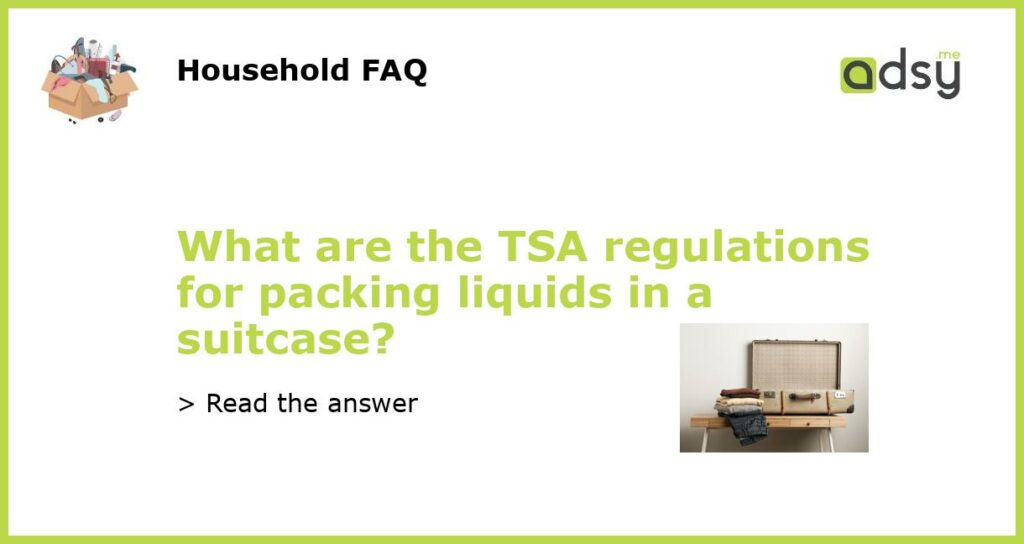The TSA regulations for packing liquids in a suitcase
If you are planning to travel by air, it’s important to be aware of the Transportation Security Administration (TSA) regulations regarding liquids in your suitcase. These regulations are in place to ensure the safety of all passengers and to prevent potential threats on board. Understanding the rules and guidelines can help you avoid any hassle or delays at the security checkpoint.
The 3-1-1 rule
The TSA’s 3-1-1 rule is a key regulation to keep in mind when packing liquids in your suitcase. The rule states that liquids, gels, and aerosols carried in your carry-on baggage must be in containers that are 3.4 ounces (100 milliliters) or less per item. These items must also be placed in a single, quart-sized, clear plastic bag with a zip-top closure. Each passenger is limited to one quart-sized bag containing these small containers.
This rule applies to all types of liquids, including toiletries such as shampoo, conditioner, body wash, toothpaste, and mouthwash. It also includes items like sunscreen, hand sanitizers, and lotions. If you have larger quantities of liquids, such as full-size bottles or containers, they should be packed in your checked baggage instead.
Exceptions for medications and baby items
While the 3-1-1 rule generally applies to all liquids, there are exceptions for certain items. Medications, including prescription and over-the-counter drugs, and medical supplies are allowed in larger quantities. These items should be properly labeled and presented separately for inspection at the security checkpoint.
Similarly, baby items, such as formula, breast milk, and baby food, are permitted in larger quantities. These items should also be presented separately for inspection, and the TSA may perform additional screening procedures on these items.
Packing tips
To ensure a smooth experience at the airport security checkpoint, it’s important to follow some additional packing tips. First, make sure all liquids are placed in leak-proof containers. This will help prevent any spills or messes in your suitcase. It’s also a good idea to pack your liquids in a separate pouch or bag within your suitcase to make them easily accessible for inspection.
Labeling your containers can also be helpful, especially if you have multiple small bottles. This way, if the TSA needs to inspect any of your liquids, they can easily identify what each item is. Finally, be sure to remove your quart-sized bag containing liquids from your carry-on bag and place it in a separate bin when going through the security checkpoint.
Additional security procedures
While the 3-1-1 rule is the main regulation regarding liquids in your suitcase, it’s important to be aware of other security procedures that may apply. The TSA reserves the right to perform additional screening on any items, including liquids. This may include manual inspection, swabbing for explosive residue, or requiring you to remove certain items from your bag for further inspection.
During the security screening process, it’s important to cooperate and follow any instructions given by TSA officers. This will help ensure a smooth and efficient process for everyone involved. If you have any questions or concerns about the security procedures, don’t hesitate to ask a TSA officer.
Flying internationally
If you are flying internationally, it’s important to note that other countries may have different regulations regarding liquids in your suitcase. Some countries may have more restrictive rules, while others may have more lenient policies. Before traveling, it’s a good idea to research and familiarize yourself with the specific regulations of your destination country.
Additionally, if you have a connecting flight in another country, you may be subject to their regulations as well. In these cases, it’s important to follow the stricter of the two sets of regulations to avoid any issues during your journey.
In conclusion, the TSA regulations for packing liquids in a suitcase are based on the 3-1-1 rule. Liquids must be in containers that are 3.4 ounces or less per item, and placed in a single, quart-sized, clear plastic bag with a zip-top closure. There are exceptions for medications and baby items, which are allowed in larger quantities. It’s important to follow packing tips, be aware of additional security procedures, and research any international regulations before traveling.






